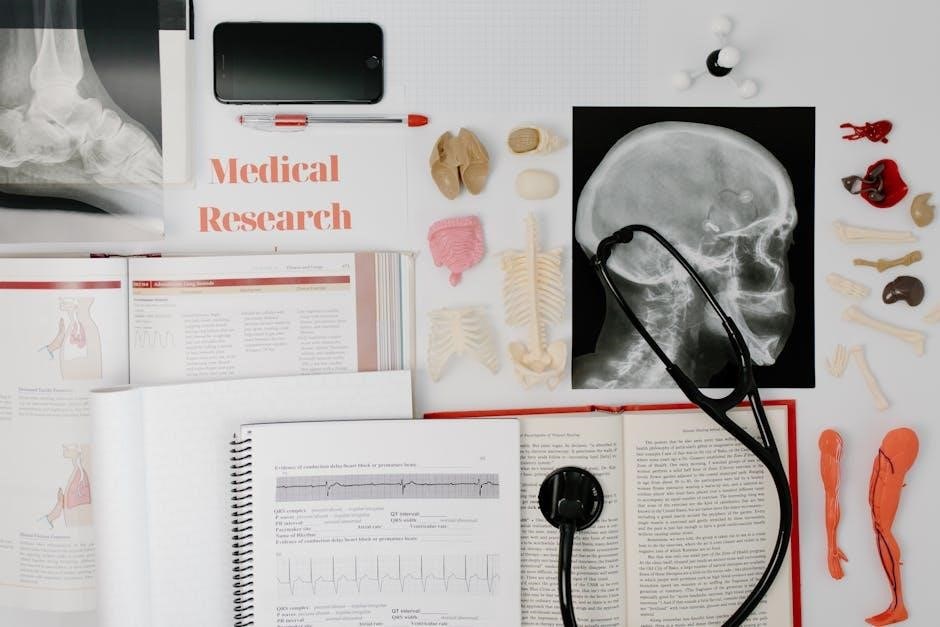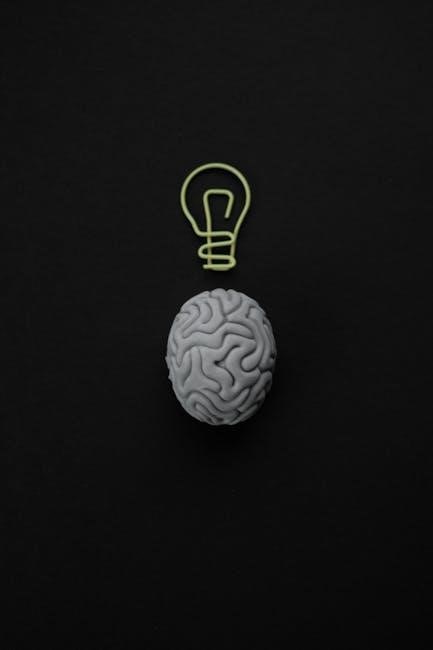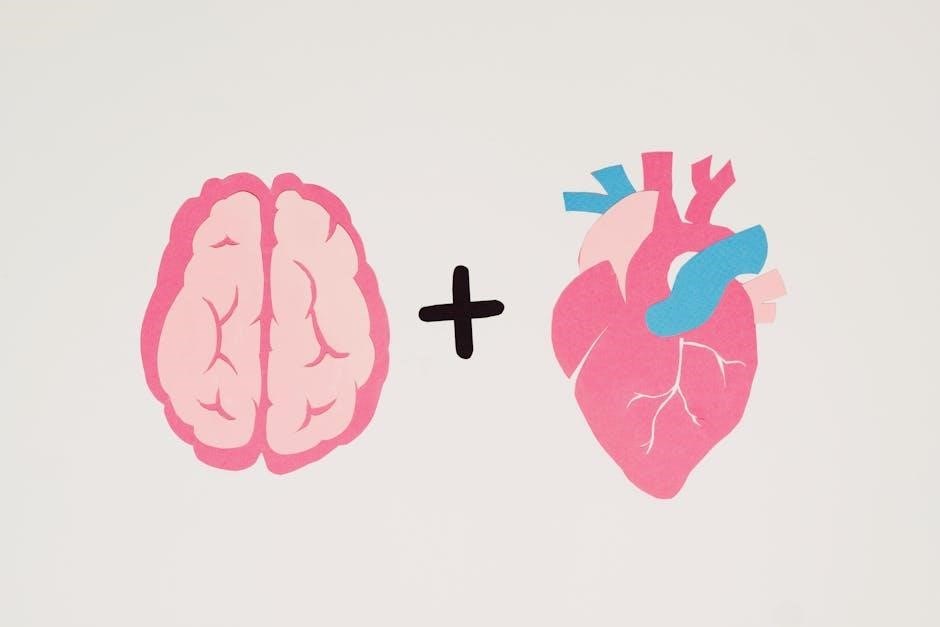Anatomy of the Brain: A Comprehensive Overview
The brain, a complex structure within the skull, governs intelligence, creativity, and emotion. Composed of the cerebrum, cerebellum, and brainstem, its anatomy follows embryonic and medical schemes. It acts as the nervous system’s control centre, processing sensory input, making decisions, and controlling movement, managing the body.
The human brain, protected by the skull, is divided into the brainstem and cerebral hemispheres. The brainstem, connecting the cerebrum and cerebellum to the spinal cord, comprises the hindbrain, midbrain, and diencephalon. The hindbrain, an extension of the spinal cord, houses vital control centres.
Brain anatomy can be understood through two schemes: the embryonic, based on developmental origins, and the medical, focusing on adult layout and function. The brain receives sensory data, controls movement, and manages the body. Its complexity is immense; its capabilities still not fully understood. It has been deemed the most complex structure.
Gross anatomical details provide a framework for understanding further chapters. Various atlases offer visual guidance, including those focused on neuroanatomy, neurophysiology, and ocular anatomy. Interactive tools, like the Digital Anatomist Project, enhance learning with 3D models. The brain’s anatomy varies by sex and age, influencing its function and connectivity.
Embryonic vs. Medical Schemes of Brain Anatomy
When studying the intricate anatomy of the brain, two primary organizational schemes are employed: the embryonic and the medical. These schemes offer distinct perspectives on brain structure, each emphasizing different aspects of its development and organization. The embryonic scheme emphasizes developmental pathways, naming regions based on their origins during embryonic development.
This approach is crucial for understanding how different brain regions arise and how they relate to each other in terms of lineage. In contrast, the medical scheme prioritizes the layout of the adult brain. It names regions based on their location and functionality. This scheme is particularly useful for clinicians and researchers who need a practical understanding of brain structure for diagnostic and treatment purposes.
The embryonic scheme provides insights into the developmental origins of brain regions, while the medical scheme offers a functional and location-based perspective. Both are essential for a comprehensive understanding of brain anatomy.
Main Parts of the Brain: Forebrain, Midbrain, and Hindbrain
The brain, the control center of the nervous system, is fundamentally divided into three main parts: the forebrain, the midbrain, and the hindbrain. Each of these regions plays a crucial role in various functions. They contribute to the brain’s overall ability to process information, control movement, and regulate bodily functions.
The forebrain, the largest part of the brain, consists of the cerebrum, thalamus, and hypothalamus. The cerebrum is responsible for higher-level cognitive functions, such as intelligence, creativity, emotion, and memory. The thalamus acts as a relay station for sensory information, while the hypothalamus regulates body temperature, hunger, and thirst.
The midbrain serves as a connecting link between the forebrain and the hindbrain. It is involved in motor control, vision, and hearing. Finally, the hindbrain, an extension of the spinal cord, comprises the cerebellum, pons, and medulla oblongata. The cerebellum coordinates movement and balance, while the pons and medulla oblongata control vital functions such as breathing, heart rate, and blood pressure.
The Brainstem: Structure and Function
The brainstem, a vital structure located at the base of the brain, acts as a relay center connecting the cerebrum and cerebellum to the spinal cord. It’s an extension of the spinal cord. It comprises three main parts: the midbrain, the pons, and the medulla oblongata. These components work together to control essential functions necessary for survival.
The midbrain is involved in motor control, vision, and auditory processing. The pons serves as a bridge between the cerebrum and the cerebellum, facilitating communication and coordination. The medulla oblongata, the lowest part of the brainstem, regulates vital autonomic functions, including breathing, heart rate, blood pressure, and reflexes like vomiting, coughing, sneezing and swallowing.
The brainstem’s structure is characterized by a dense network of neurons that form control centers for these vital functions. Damage to the brainstem can result in severe neurological deficits, potentially leading to coma or even death. Its crucial role in maintaining life underscores the importance of understanding its anatomy and function.
Cerebrum: Anatomy and Role in Higher Functions
The cerebrum, the largest part of the brain, is responsible for higher-level cognitive functions. Divided into two hemispheres, left and right, connected by the corpus callosum, it facilitates communication. Each hemisphere is further divided into four lobes: frontal, parietal, temporal, and occipital, each with specialized functions.
The frontal lobe governs executive functions, including planning, decision-making, and working memory. The parietal lobe processes sensory information, spatial awareness, and navigation. The temporal lobe is involved in auditory processing, memory formation, and language comprehension. The occipital lobe is dedicated to visual processing.
The cerebral cortex, the outer layer of the cerebrum, is highly folded, increasing surface area for neural processing. This intricate structure enables complex functions like language, reasoning, and abstract thought. The cerebrum’s anatomy and intricate network of connections support intelligence, creativity, and the capacity for learning and adaptation, making it central to human experience. Its complexity allows for a wide range of cognitive abilities.
Cerebellum: Structure and Function

The cerebellum, located at the back of the brain, plays a crucial role in motor control, coordination, and balance. Its name means “little brain,” and it has a densely packed structure containing over half of the brain’s neurons. It receives input from the cerebral cortex, spinal cord, and brainstem to fine-tune movements.
Anatomically, the cerebellum consists of two hemispheres connected by the vermis. Its surface is highly folded, forming folia that increase surface area. The cerebellar cortex contains several layers of neurons, including Purkinje cells, granule cells, and molecular layer interneurons, which work together to process motor information.
The cerebellum doesn’t initiate movement but refines and coordinates it, ensuring smooth and accurate execution. It is also involved in motor learning, adapting movements to changing conditions. Damage to the cerebellum can result in ataxia, characterized by impaired coordination and balance. Beyond motor control, the cerebellum also contributes to cognitive functions, including language and attention.
Gross Anatomy of the Brain: An Overview
The gross anatomy of the brain refers to its macroscopic structures, visible without magnification. The brain, protected by the skull, is divided into the cerebrum, cerebellum, and brainstem. The cerebrum, the largest part, consists of two hemispheres connected by the corpus callosum, responsible for higher cognitive functions.
The cerebral cortex, the outer layer of the cerebrum, is highly folded, forming gyri and sulci, increasing surface area. The cerebellum, located at the back, coordinates movement and balance. The brainstem connects the cerebrum and cerebellum to the spinal cord, controlling vital functions like breathing and heart rate.

The brain also contains ventricles, fluid-filled spaces that produce and circulate cerebrospinal fluid (CSF), cushioning and protecting the brain. The meninges, three layers of protective membranes, surround the brain and spinal cord. Understanding the gross anatomy provides a framework for studying the brain’s intricate functions and how different regions interact. Detailed anatomical frameworks are crucial for chapters that follow.
Atlas of Brain Anatomy: Resources and Tools
Exploring the intricate landscape of the brain necessitates the use of comprehensive atlases and tools. These resources provide detailed anatomical frameworks, aiding in the visualization and understanding of complex neural structures. Several atlases are available, including both traditional printed versions and interactive digital platforms.
Digital atlases, like the neuroanatomy interactive atlas of the Digital Anatomist Project, offer 3D visualizations and interactive features, enhancing the learning experience. These platforms often include labeled structures, cross-sectional views, and the ability to rotate and manipulate the brain model.
Furthermore, resources such as “Atlas of Morphology and Functional Anatomy of the Brain” provide detailed anatomical information alongside functional correlations. Software tools, such as the JuBrain Anatomy Toolbox, offer advanced capabilities for brain mapping and analysis. These atlases and tools are essential for students, researchers, and clinicians seeking to navigate the complexities of brain anatomy, facilitating a deeper understanding of its structure and function. They are not allowed to be revised without permission.

JuBrain Anatomy Toolbox
The JuBrain Anatomy Toolbox, also known as the SPM Anatomy Toolbox, is a powerful software resource for exploring and analyzing brain anatomy. This toolbox offers a range of functionalities for brain mapping, region definition, and cytoarchitectonic analysis. It provides detailed information about the location and structure of different brain areas.
The toolbox is particularly useful for researchers and clinicians who need to identify and delineate specific brain regions. It allows users to access high-resolution brain maps and atlases, enabling precise localization of anatomical structures. Furthermore, the JuBrain Anatomy Toolbox integrates with other neuroimaging software, facilitating the analysis of functional and structural brain data.
This integration allows for a comprehensive understanding of brain organization and function. The toolbox is not allowed to revise or amend the provided products or extract only parts of it, e.g. the brain maps, without the explicit permission. The JuBrain Anatomy Toolbox stands as a valuable asset in the field of neuroimaging and brain research, offering advanced tools for anatomical exploration.
Clinical Significance of Brain Anatomy
Understanding brain anatomy is paramount in clinical settings, impacting diagnosis, treatment planning, and surgical interventions. Anatomical knowledge allows clinicians to identify and localize lesions, tumors, and other abnormalities within the brain. Detailed understanding guides the interpretation of neuroimaging scans, such as MRIs and CT scans, enabling accurate diagnosis of neurological disorders.
In neurosurgery, precise anatomical knowledge is crucial for planning and executing surgical procedures. Surgeons rely on anatomical landmarks to navigate the brain and avoid damaging critical structures. Furthermore, understanding the vascular anatomy of the brain is essential to prevent complications during surgery.
Neurological disorders, such as stroke, traumatic brain injury, and neurodegenerative diseases, often result in specific anatomical changes in the brain. By understanding these changes, clinicians can better assess the severity of the condition and tailor treatment strategies accordingly. Moreover, knowledge of brain anatomy helps in understanding the functional consequences of anatomical damage, allowing for targeted rehabilitation efforts. The clinical significance of brain anatomy cannot be overstated, as it forms the foundation of effective neurological care.
Variations in Brain Anatomy: Sex and Age Differences
Brain anatomy exhibits variations related to both sex and age, reflecting developmental and hormonal influences. Studies using MRI have revealed subtle but consistent sex differences in brain structure, including variations in regional volumes and cortical thickness. While overall brain size tends to be larger in males, certain regions, such as the hippocampus, may be relatively larger in females. These differences may contribute to variations in cognitive abilities and susceptibility to neurological disorders.
Age-related changes in brain anatomy are also well-documented. During childhood and adolescence, the brain undergoes significant growth and maturation, with increases in grey matter volume and myelination. As individuals age, the brain experiences gradual atrophy, characterized by a decline in grey matter volume and white matter integrity. These changes can affect cognitive function and increase the risk of neurodegenerative diseases.

Furthermore, sex hormones, such as estrogen and testosterone, play a role in shaping brain anatomy and function. These hormones can influence neuronal development, synaptic plasticity, and neuroprotection. Understanding the interplay between sex, age, and brain anatomy is crucial for comprehending individual differences in cognition, behavior, and neurological health.
